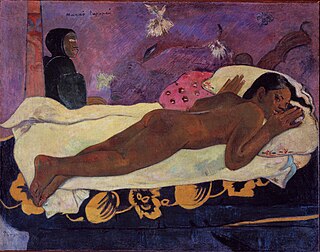Related Research Articles

The Polynesian narrative or Polynesian mythology encompasses the oral traditions of the people of Polynesia together with those of the scattered cultures known as the Polynesian outliers. Polynesians speak languages that descend from a language reconstructed as Proto-Polynesian - probably spoken in the Tonga - Samoa area around 1000 BC.
Tangaroa is the great atua of the sea, lakes, rivers, and creatures that live within them, especially fish, in Māori mythology. As Tangaroa-whakamau-tai he exercises control over the tides. He is sometimes depicted as a whale.
Atea is a deity in several Polynesian cultures, including the Marquesas and Tuamotu Islands, and New Zealand.
Samoan culture tells stories of many different deities. There were deities of the forest, the seas, rain, harvest, villages, and war. There were two types of deities, atua, who had non-human origins, and aitu, who were of human origin.
In Samoan mythology, Tagaloa is generally accepted as the supreme ruler, the creator of the universe, the chief of all gods and the progenitor of other gods and humans. Tagaloa dwelt in space and made the Heavens (lagi), the sky, the land, the seas, the fresh water, the trees and the people. Samoans believed Tagaloa created nine heavens. After Tagaloa made the islands, the humans developed from worms.

In Hawaiian mythology, Laka is the name of two different popular heroes from Polynesian mythology.. Lengthy legends of their exploits extend throughout the islands, and the kings of Tahiti and Hawaiʻi claimed them as their ancestors.
In Polynesian mythology, Haronga ("daybreak") is a god of the dawn and father of Atarapa. He is a son of Rangi and Papa.
In Polynesian mythology, Hine-Tu-Whenua is a kind and beneficent wind goddess. She was very helpful toward sailors and helped them reach their destinations safely. Hineitapapauta is considered her mother.
In Polynesian mythology, Kohara is the goddess of tuna and is considered the "mother of all tuna fish". The word also means "to throw a flash of lightning, as a deity". In Māori mythology, lightning begat tuna. In that sense, Kohara can be considered the "ancestor of tuna".
Motoro is a god in Polynesian mythology, the tribal god of the Ngariki of Mangaia. He is the son of Tangiia and the brother of Ruanuku, Kereteki and Utakea. While travelling to Mangaia he argued with his two eldest brothers, was thrown into the sea, and devoured by sharks. His spirit then floated to Mangaia on a piece of hibiscus. He was known as i'o ora because his followers could not be used as human sacrifices.
In Polynesian mythology, Tuna is a god of eels. In Hawaiian mythology he fights with Māui, who is having an affair with his wife Hina. Māui kills him, cuts off his head, and plants it near his home. A green shoot emerges from the spot where the head was buried, and grows into the first coconut palm. In the mythology of Mangaia Tuna is the lover of Hine, and asks that his head be cut off and planted in order to stop a flood. A coconut shoot grows from the head. A variant of the story is told in the Samoan myth of Sina and the Eel.
In Samoan legend, the mythological figure Tiʻitiʻi Atalaga appears in legends very similar to those recounting the tales of the demigod Māui, found in other island cultures. In one such legend, which is almost identical to the New Zealand fire myth of Māui Tikitiki-a-Taranga, he succeeds in bringing fire to the people of Samoa after a battle with the earthquake god, Mafui'e. During the battle, Ti'iti'i breaks off one of Mafui'e's arms, forcing him to agree to teach him of how fire had been concealed by the gods in certain trees during the making of the world. The people of Samoa were thankful to Ti'iti'i for breaking off Mafui'e's arm, as they believed that he was less able to create large earthquakes as a result.

Rapa Nui mythology, also known as Pascuense mythology or Easter Island mythology, refers to the native myths, legends, and beliefs of the Rapa Nui people of Easter Island in the south eastern Pacific Ocean.
Chilean mythology includes the mythology, beliefs and folklore of the Chilean people.

Sina and the Eel is a myth of origins in Samoan mythology, which explains the origins of the first coconut tree.

There was widespread belief in ghosts in Polynesian culture, some of which persists today. After death, a person's ghost would normally travel to the sky world or the underworld, but some could stay on earth. In many Polynesian legends, ghosts were often involved in the affairs of the living. Ghosts might also cause sickness or even invade the body of ordinary people, to be driven out through strong medicines.

Cook Islands mythology comprises historical myths, legends, and folklore passed down by the ancient Cook Islanders over many generations. Many of the Cook Islands legends were recited through ancient songs and chants. The Cook Islands myths and legends have similarities to general Polynesian mythology, which developed over the centuries into its own unique character.
Niuean mythology relates to some of the myths prevalent on the island of Niue, an Oceanic island country in free association with New Zealand. Although Niuean mythology reports a colonization before 500 AD, the island was settled by Polynesians from Samoa around 900 AD. The five principal gods of Niue are known as the tupua, and include Fao, Huanaki, Fakahoko, Laga-iki, and Lagi-atea, who by various accounts, arrived from Fonuagalo, Tulia, Toga-liulu, or perhaps other islands. In Avatele myths, the gods are said to have come from within the earth instead of Fonuagalo. There are also many other gods in Niuean mythology from fish gods to flying rats.
Adi-mailagu is a Polynesian sky goddess of the Fijian people.